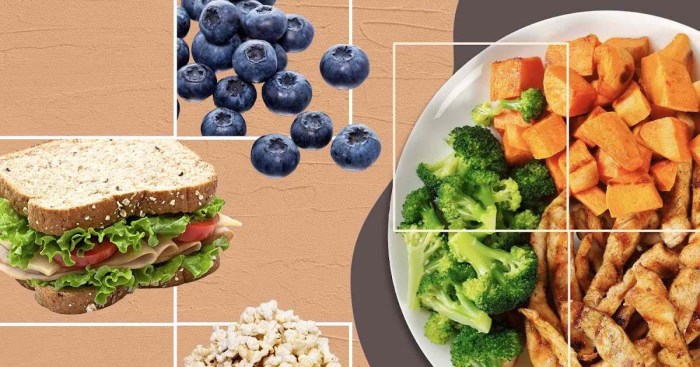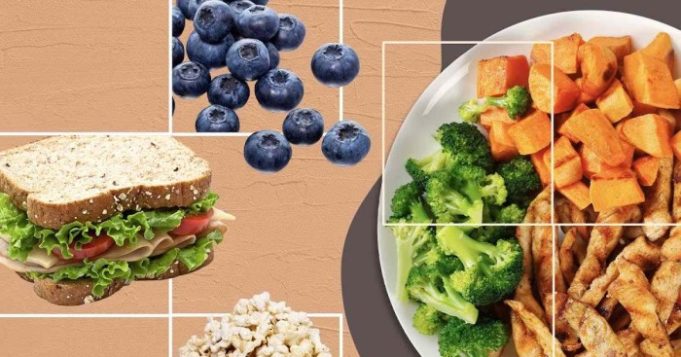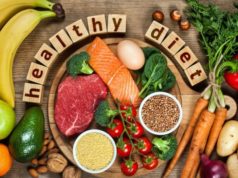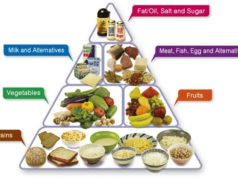How to reduce cholesterol with diet is a topic that often sparks concern, but it’s also one that empowers individuals to take control of their health. Cholesterol, a waxy substance found in our blood, is crucial for building healthy cells, but high levels can increase the risk of heart disease. Understanding the different types of cholesterol and their roles in the body is essential for making informed dietary choices. This guide explores practical strategies for lowering cholesterol through dietary modifications, offering a comprehensive approach to improving cardiovascular health.
This guide will delve into the science behind cholesterol, examine the foods that contribute to high cholesterol levels, and provide a roadmap for incorporating cholesterol-lowering foods into your diet. We’ll also explore lifestyle modifications that complement dietary changes, empowering you to make sustainable choices for a healthier future.
Understanding Cholesterol: How To Reduce Cholesterol With Diet
Cholesterol is a waxy, fat-like substance found in all cells of your body. It plays a vital role in the production of hormones, vitamin D, and cell membranes. While cholesterol is essential for good health, high levels can increase your risk of heart disease.
Types of Cholesterol
Cholesterol exists in two main forms: low-density lipoprotein (LDL) and high-density lipoprotein (HDL).
- LDL cholesterol, often referred to as “bad cholesterol,” contributes to plaque buildup in your arteries. This buildup can restrict blood flow and increase the risk of heart attack or stroke.
- HDL cholesterol, known as “good cholesterol,” helps remove LDL cholesterol from your bloodstream and transport it to your liver for processing. Higher levels of HDL cholesterol are associated with a lower risk of heart disease.
High Cholesterol
High cholesterol refers to having too much LDL cholesterol in your blood. When LDL cholesterol builds up in your arteries, it can form a substance called plaque. This plaque hardens and narrows your arteries, making it harder for blood to flow through. This condition is called atherosclerosis.
Factors Contributing to High Cholesterol
Several factors can contribute to high cholesterol levels, including:
- Genetics: A family history of high cholesterol can increase your risk.
- Diet: Consuming a diet high in saturated and trans fats can raise your LDL cholesterol levels.
- Lack of Exercise: Regular physical activity can help raise your HDL cholesterol levels.
- Age: Cholesterol levels tend to increase with age.
- Weight: Being overweight or obese can increase your risk of high cholesterol.
- Medical Conditions: Certain medical conditions, such as diabetes and hypothyroidism, can contribute to high cholesterol.
- Medications: Some medications, such as corticosteroids and certain diuretics, can raise cholesterol levels.
Dietary Strategies for Lowering Cholesterol
Making dietary changes is a crucial step in managing high cholesterol. By understanding the foods that contribute to high cholesterol and incorporating those that help lower it, you can take control of your health.
Foods High in Saturated and Trans Fats
Saturated and trans fats, found in many processed foods and animal products, raise LDL (bad) cholesterol levels.
- Animal Products: Red meat (beef, pork, lamb), poultry with skin, full-fat dairy products (butter, cheese, whole milk), and eggs are high in saturated fats.
- Processed Foods: Many processed foods, including fried foods, baked goods, and snacks, are high in saturated and trans fats. Look for labels that mention “partially hydrogenated oil,” which indicates the presence of trans fats.
- Palm and Coconut Oil: While often marketed as healthy, these oils are high in saturated fats and should be consumed in moderation.
Foods Rich in Cholesterol
Cholesterol is naturally present in some foods, primarily animal products.
- Organ Meats: Liver, kidney, and brains are particularly high in cholesterol.
- Shellfish: Shrimp, crab, and lobster are high in cholesterol.
- Egg Yolks: While eggs are a good source of protein, the yolk contains a significant amount of cholesterol.
Sample Meal Plan for Lowering Cholesterol
Here is a sample meal plan that incorporates foods that help lower cholesterol:
- Breakfast: Oatmeal with berries and nuts, a whole-grain English muffin with avocado, or a smoothie made with fruits, vegetables, and non-fat yogurt.
- Lunch: A salad with grilled chicken or fish, a lentil soup, or a whole-grain wrap with hummus and vegetables.
- Dinner: Baked salmon with roasted vegetables, lentil or vegetable stir-fry, or vegetarian chili.
- Snacks: Fruits, vegetables, nuts, or plain yogurt.
Food Choices for Reducing Cholesterol

Making smart food choices is a key strategy for lowering your cholesterol. By understanding which foods can help reduce LDL (bad) cholesterol and raise HDL (good) cholesterol, you can create a diet that supports your heart health.
Food Choices for Lowering Cholesterol
| Food Group | Examples | Cholesterol-Lowering Benefits | Serving Suggestions |
|---|---|---|---|
| Fruits and Vegetables | Apples, bananas, berries, broccoli, carrots, spinach | Rich in fiber, which binds to cholesterol in the gut and helps remove it from the body. | Aim for at least 5 servings of fruits and vegetables per day. |
| Whole Grains | Brown rice, quinoa, oatmeal, whole-wheat bread | Provide soluble fiber, which helps lower LDL cholesterol. | Choose whole grains over refined grains whenever possible. |
| Legumes | Beans, lentils, peas | Excellent sources of soluble fiber and protein, which can help lower LDL cholesterol and improve blood sugar control. | Incorporate legumes into meals and snacks. |
| Nuts and Seeds | Almonds, walnuts, flax seeds, chia seeds | Rich in monounsaturated and polyunsaturated fats, which can help lower LDL cholesterol and raise HDL cholesterol. | Enjoy a handful of nuts or seeds as a snack or add them to yogurt, salads, or oatmeal. |
| Fatty Fish | Salmon, tuna, mackerel, sardines | Excellent sources of omega-3 fatty acids, which have been shown to lower triglycerides and improve heart health. | Aim to eat fatty fish at least twice a week. |
| Soy Products | Tofu, tempeh, soy milk | Contain plant-based protein and fiber, which can help lower cholesterol levels. | Incorporate soy products into your diet in place of animal products. |
Healthy Fats
Not all fats are created equal. Monounsaturated and polyunsaturated fats are considered “healthy” fats and can help lower LDL cholesterol and raise HDL cholesterol. These fats are found in a variety of foods, including:
- Monounsaturated fats: Olive oil, avocados, nuts (almonds, cashews, peanuts), seeds (pumpkin seeds, sesame seeds), olives
- Polyunsaturated fats: Vegetable oils (corn oil, soybean oil, sunflower oil), fatty fish (salmon, tuna, mackerel, sardines), nuts (walnuts, flaxseeds, chia seeds)
These healthy fats can help improve heart health by:
- Lowering LDL cholesterol
- Raising HDL cholesterol
- Reducing inflammation
- Improving blood vessel function
Fiber-Rich Foods
Fiber is a type of carbohydrate that the body cannot digest. There are two types of fiber: soluble and insoluble. Soluble fiber dissolves in water and forms a gel-like substance in the gut, which helps lower LDL cholesterol. Insoluble fiber does not dissolve in water and adds bulk to stool, which can help prevent constipation. Fiber-rich foods include:
- Fruits: Apples, bananas, berries, pears, oranges
- Vegetables: Broccoli, Brussels sprouts, carrots, peas, spinach
- Whole grains: Brown rice, quinoa, oatmeal, whole-wheat bread
- Legumes: Beans, lentils, peas
- Nuts and seeds: Almonds, walnuts, flaxseeds, chia seeds
In addition to lowering cholesterol, fiber can also help:
- Regulate blood sugar levels
- Promote a healthy weight
- Reduce the risk of heart disease, stroke, and type 2 diabetes
Practical Tips for a Cholesterol-Friendly Diet
Making changes to your diet can significantly impact your cholesterol levels. By incorporating practical tips into your daily routine, you can effectively reduce saturated and trans fats, minimize fat intake during cooking, and make healthier choices for a cholesterol-friendly lifestyle.
Reducing Saturated and Trans Fats
Saturated and trans fats are known to raise LDL (bad) cholesterol levels, increasing the risk of heart disease. Here are some strategies to reduce their intake:
- Choose lean meats: Opt for lean cuts of meat like chicken breast, turkey breast, and fish. Trim visible fat from meats before cooking.
- Limit processed foods: Processed foods like sausages, bacon, and fried foods are often high in saturated and trans fats. Choose whole, unprocessed options instead.
- Read food labels: Pay close attention to the fat content of packaged foods. Look for products labeled as “low-fat” or “fat-free.”
- Limit dairy products: Full-fat dairy products like whole milk, butter, and cheese are high in saturated fat. Choose low-fat or non-fat alternatives.
- Avoid trans fats: Trans fats are found in many processed foods and are particularly harmful to heart health. Look for products labeled as “trans fat-free” or “zero grams trans fat.”
Cooking Methods that Minimize Fat Intake
The way you cook your food can significantly impact its fat content. Here are some healthier cooking methods:
- Grilling: Grilling is a great way to cook meat and vegetables without adding extra fat. Use a grill pan or outdoor grill.
- Baking: Baking is another healthy cooking method that requires little or no added fat. Use a baking sheet or oven-safe dish.
- Steaming: Steaming is a gentle cooking method that preserves nutrients and requires no added fat. Use a steamer basket or a pot with a steamer insert.
- Sautéing: Sautéing can be a healthy cooking method if you use a small amount of healthy oil, like olive oil or avocado oil.
- Boiling: Boiling is a simple and healthy cooking method that requires no added fat. Use a pot of water on the stovetop.
Healthy Substitutions for High-Cholesterol Foods
Instead of reaching for high-cholesterol foods, consider these healthier alternatives:
- Egg whites instead of whole eggs: Egg whites are a good source of protein without the cholesterol found in the yolk.
- Plant-based milk alternatives instead of cow’s milk: Almond milk, soy milk, and oat milk are lower in saturated fat than cow’s milk.
- Avocado instead of butter: Avocado is a healthy fat that can be used as a spread or in cooking.
- Legumes instead of red meat: Beans, lentils, and chickpeas are good sources of protein and fiber, and they are lower in saturated fat than red meat.
- Nuts and seeds instead of chips: Nuts and seeds are a healthy snack that can help lower cholesterol.
Lifestyle Modifications for Cholesterol Management
Beyond dietary changes, incorporating lifestyle modifications can significantly contribute to lowering cholesterol levels and improving overall health. These modifications work in synergy with dietary strategies, creating a holistic approach to cholesterol management.
Benefits of Regular Physical Activity
Regular physical activity plays a crucial role in lowering cholesterol levels. When you engage in physical activity, your body uses more energy, leading to a decrease in the amount of low-density lipoprotein (LDL) cholesterol, often referred to as “bad” cholesterol, in your bloodstream. This is because physical activity helps your body remove LDL cholesterol from the blood and transport it to the liver for processing. Additionally, physical activity increases high-density lipoprotein (HDL) cholesterol, the “good” cholesterol, which helps remove LDL cholesterol from the bloodstream.
Impact of Maintaining a Healthy Weight
Maintaining a healthy weight is essential for managing cholesterol levels. When you are overweight or obese, your body produces more LDL cholesterol, which can lead to a buildup of plaque in your arteries, increasing your risk of heart disease. Losing even a small amount of weight can have a significant impact on lowering cholesterol levels.
Healthy Habits to Complement Dietary Changes, How to reduce cholesterol with diet
- Stress Management: Chronic stress can elevate cholesterol levels. Practicing stress-reducing techniques like yoga, meditation, or deep breathing exercises can help manage stress and its impact on cholesterol.
- Adequate Sleep: Getting enough sleep is crucial for overall health, including cholesterol management. When you don’t get enough sleep, your body produces more cortisol, a stress hormone that can raise cholesterol levels. Aim for 7-8 hours of quality sleep each night.
- Regular Medical Checkups: Regular medical checkups are essential for monitoring your cholesterol levels and overall health. Your doctor can provide personalized advice and guidance based on your individual needs and health history.
Wrap-Up
By understanding the relationship between diet and cholesterol, you can empower yourself to make informed choices that support cardiovascular health. By embracing a cholesterol-friendly diet, incorporating regular physical activity, and maintaining a healthy weight, you can take proactive steps towards a healthier lifestyle. Remember, a balanced approach that incorporates both dietary changes and lifestyle modifications is key to effectively managing cholesterol levels and promoting overall well-being.
Quick FAQs
What are the best foods to lower cholesterol?
Foods rich in soluble fiber, such as oats, beans, lentils, and fruits like apples and pears, are known to help lower cholesterol levels. Incorporating these into your diet can make a significant difference.
How much exercise is recommended for lowering cholesterol?
Aim for at least 30 minutes of moderate-intensity exercise most days of the week. This could include brisk walking, swimming, cycling, or dancing.
Can I lower my cholesterol without medication?
While medication may be necessary for some individuals, many people can significantly lower their cholesterol through lifestyle changes, including dietary modifications and regular exercise.
Lowering cholesterol through diet often involves incorporating heart-healthy foods like fruits, vegetables, and lean proteins. But what if you also have Irritable Bowel Syndrome (IBS)? Finding the right balance can be tricky. A good place to start is by learning about Whats the Best Diet for Irritable Bowel Syndrome?
. This can help you identify foods that trigger your IBS symptoms and make adjustments to your diet to manage both cholesterol and IBS.
Reducing cholesterol through diet requires a thoughtful approach. You need to understand which foods to limit and which to prioritize, and that’s where a solid diet plan comes in handy. Learning How to Make a Diet Plan That Works can help you create a sustainable plan that incorporates heart-healthy choices, making it easier to manage your cholesterol levels in the long run.
Managing cholesterol levels through diet is a key aspect of overall health. You might be surprised at the number of dietary approaches that can help, ranging from the Mediterranean diet to the DASH diet. To better understand the options, check out Different Diet Names: A Comprehensive Guide which provides a detailed overview of popular dietary plans.
Armed with this knowledge, you can make informed choices to create a personalized plan that effectively addresses your cholesterol concerns.
























